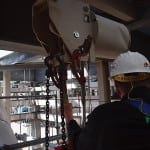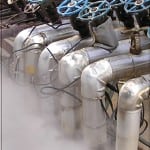As coal-fired power plants increasingly operate in cycling modes, many plants are confronting the potential for higher levels of component damage and degraded performance of environmental control equipment. Generators and EPRI are working together to find ways to mitigate the effects of cycling operation and to manage the transition of formerly baseload plants to flexible operation.
Coal-fired power generating units in the U.S. continue to switch from high-capacity-factor operation to various modes of flexible operation. Cycling and load following are not new. However, over the past decade, and in particular the past few years, a perfect storm of factors has gathered to require even baseload coal plants to prepare for increased flexible operation.
The first factor is reduced demand caused by the recent recession. From 2008 to 2009, overall electricity demand in the U.S. declined 4%, according to the Energy Information Administration (EIA). An Electric Power Research Institute (EPRI) study, “Unprecedented Generation Shifts” (funded by the Power Technology, Market Analysis, and Risk Program), found that in 2009, coal-fired generation declined 11.1%, or about 75 terawatt-hours (TWh). That was the greatest recorded one-year decline in coal generation.
The second factor is lower natural gas prices and increased coal-to-gas switching. In 2008–2009, gas prices declined significantly, making gas-fired generation a lower-cost option for economic dispatch than coal-fired plants. In the same two-year time period, the net capacity factor for gas-fired combined cycle plants increased by 5%.
The third factor, which will play a role in the next decade, even when the economy improves, is increased deployment of intermittent renewable generation (principally wind) in certain regions of the U.S. That increased variable generation is forcing coal and combined cycle plants to provide system load-balancing services. The EIA reports that the amount of nondispatchable generation in the U.S. increased by a factor of four from 2005 to 2009. Wind generation alone increased from 18 TWh to 71 TWh during this period. Contributing to the complications for coal-fired plants, renewable generation is typically dispatched as “must-take,” and the trends in both seasonal and daily wind production are often out of phase with demand.
The overall impact of these trends for coal plants has been increases in various modes of flexible operation, with the following operational impacts: increased load-following operation, higher unit turndown during low demand, lower minimum load operating, two-shifting, frequent unit starts (hot, warm, and cold), increased load and thermal ramp rates, frequent reserve shutdown, and long-term plant layup.
For example, analysis of data from the North American Electric Reliability Corp.’s Generating Availability Data System, as reported by coal units in the 2005–2009 timeframe, indicates an increase in reserve shutdown hours in 2009. This increase is observed across a range of unit sizes, in both supercritical and subcritical designs. In turn, this trend has produced a reduction in reported net capacity factor, particularly for older subcritical units, which are experiencing high turndown.
From Baseload to Flexible Operation
Few coal-fired units in the existing U.S. coal fleet are designed specifically for flexible operation. In 2009, more than 60% of the total North American subcritical coal-fired generation was produced by units commissioned prior to 1980. Those were primarily baseload units constructed during the 1960s and 1970s to meet expected trends in demand growth. Since 1980, power producers have opted to build large-capacity, more-efficient units with supercritical steam conditions, which are also designed for baseload operation.
New duty cycles force baseload plants and equipment to operate closer to—or beyond––nominal design limits and through more thermal cycles than originally anticipated. The operational impacts of flexible operation cited earlier result in significantly increased occurrences of thermal transients in the material of critical high-temperature boiler and turbine components. These transients, and other operational factors associated with flexible operation, have the following effects on coal-fired generating assets:
- Increased rate of wear on high-temperature components.
- Increased wear-and-tear on balance-of-plant components.
- Decreased thermal efficiency at low load (high turndown).
- Increased fuel costs due to more frequent unit starts.
- Difficulties in maintaining optimum steam chemistry.
- Potential for catalyst fouling in NOx control equipment.
- Increased risk of human error in plant operations.
Additional wear on plant components requires increased spending on preventive and corrective maintenance. This requirement is often challenging to plants that are placed lower on the dispatch stack and that, therefore, receive less revenue and operating budget. Increased human error is due primarily to the increased amount of transient operation, which produces more opportunities for error. Major plant events caused by human error can result in costly equipment damage and related safety challenges.
Damage Mechanisms
Load following involves rapid increases and decreases in process temperatures, which create significant thermal stress on pressure boundaries. When plant loads change, the consequences are numerous: pulverizers or mills go off and on, furnace temperatures and heat profiles are altered, pollution control requirements change, and steam and flue gas velocities vary. All of these changes can force the unit to operate away from the original design point.
A few important material damage mechanisms are responsible for the majority of the financial impacts caused by operating coal plants in flexible modes. The severity of the impact of these mechanisms can be mitigated to a certain extent through improved plant operation and process controls, but it is impossible to completely eliminate the reduction in major component life caused by flexible operation. Examples of these damage mechanisms follow.
Thermal Fatigue. This phenomenon can produce cracking in thick-walled components, especially castings such as turbine valves and casings. Also affected are boiler superheater and reheater headers, where ligament cracking is commonly seen between tube stubs. These headers are expensive, thick-walled vessels operating under high steam pressure, making this damage of particular concern to plant owners. Header cracking (Figure 1) is caused by frequent, large temperature swings associated with flexible operation and, in some cases, by thermal quenching produced either by condensate formed during idle standby or poorly controlled attemperator sprays (again associated with transient operation).
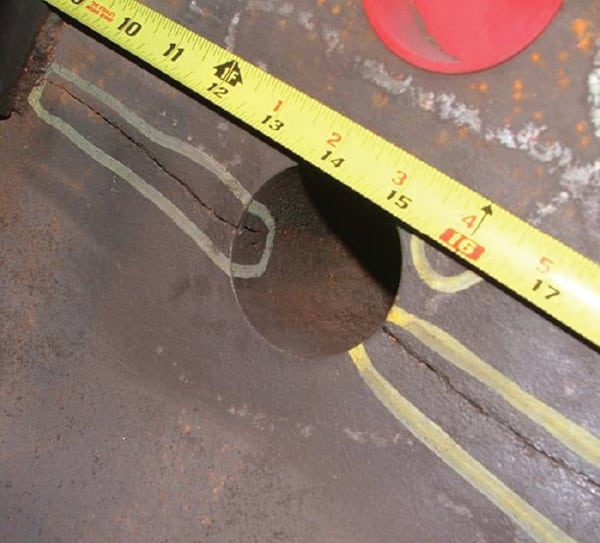 |
| 1. Cracked header. Cold feedwater introduced to a hot header caused the crack in this economizer header. The cold water created a large through-wall temperature gradient change in temperature during startup and during off-line top-off opportunities. Courtesy: EPRI |
Thermal Expansion. Several systems in a coal plant consist of components that undergo high thermal growth relative to surrounding components. The most important example of this phenomenon is the large movement of boiler structures relative to the cooler support framework. This part of a plant includes waterwall sections, gas ductwork, and the ties used to support superheat and reheat tubing. These support ties are designed to accommodate growth but are subject to accelerated life consumption if the frequency of thermal cycling increases. Differential expansion also contributes to tube-to-header cracking in superheaters and reheaters (Figure 2).
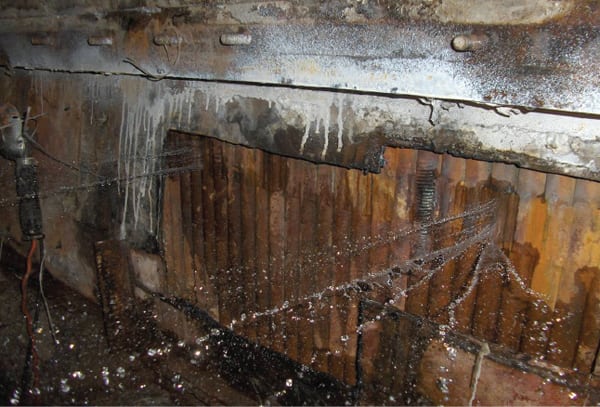 |
| 2. Leaky tubes. Tube-to-header cracking caused by thermal transients is shown in this photo. Variation in tube thermal expansion, caused by differences in tube length, increases stress in some tubes. Courtesy: EPRI |
Corrosion-Related Issues. Two-shifting, or any other operation that challenges the ability of a plant to maintain water chemistry, can lead to increased corrosion and accelerated component failure. Increased levels of dissolved oxygen in feedwater can be the result of condenser leaks, aggravated by more-frequent shutdowns. Other factors affecting chemistry include the increased need for makeup water and the interruption in operation of the condensate polishers and deaerators. Corrosion and fatigue can combine to accelerate damage to waterwalls (Figure 3).
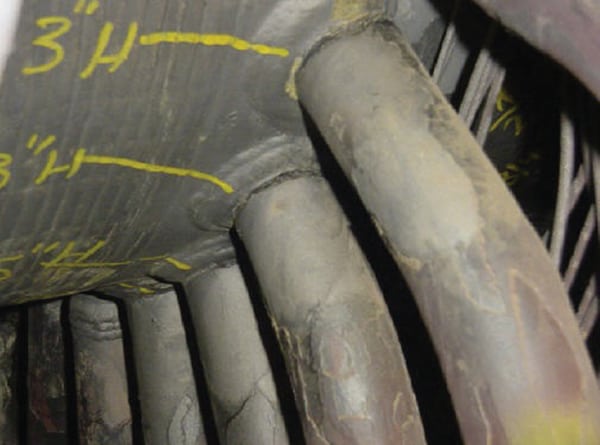 |
| 3. Waterwall cracks. Waterwall damage caused by corrosion fatigue is often found in steam generators. Courtesy: EPRI |
Fireside Corrosion. Load cycling and relatively quick ramp rates under staged conditions will have a negative impact on both fireside corrosion and circumferential cracking.
Rotor Bore Cracking. When subjected to transients in the temperature of the admitted steam, the high-pressure and intermediate-pressure steam turbine rotors can suffer thermo-mechanical stress excursions, resulting in low-cycle fatigue damage. This damage can result either from introducing hot steam to a relatively cold rotor exterior, or the opposite. In both scenarios, the problem arises from the massive rotor forging and the resulting time required for the metal temperature difference between the rotor exterior surface and the inner (bore) region to equilibrate.
Impacts on Environmental Control Equipment
Load following and other modes of flexible operation can affect the performance and reliability of flue gas desulfurization (FGD) equipment and selective catalytic reduction (SCR) systems. The chemical processes involved in these systems require precise control of the reaction conditions, which are influenced by reagent flow, water flow, and flue gas temperature.
Startups of FGD systems should be minimized because of the need to purge systems to avoid slurry solidification, the impact of fuel oil residues on linings, and their lengthy warm-up time. Low-load operation of FGD systems may be difficult to optimally control if the reagent flow is at a fixed rate.
Operation of large coal-fired plants at low load can force units with SCR systems to operate with lower flue gas temperatures. Low temperatures create operational problems for SCRs because of the formation of ammonium bisulfate (ABS), a sticky liquid that can fill catalyst pores, thus diminishing catalyst surface area and reducing reactivity.
Strategies for Mitigating Flexible Operation Damage
A range of strategies will be needed to mitigate damage to coal units caused by flexible operation. These strategies should be generally assessed in terms of benefit-to-cost ratio when selecting action plans for specific units. Significant capital investment in improved-design boiler components may be warranted for new, efficient units with control technology installed.
In older plants, the most cost-effective strategy from a life-cycle cost perspective may be to focus on improved operator performance and selected plant controls upgrades. This approach could also include installation of additional process sensors (typically temperature), strategically located to guide operators through transients to reduce damaging over-temperature events. Increased attention to the location, operation, and capacity of drains is another cost-effective operation and maintenance strategy.
EPRI has undertaken a number of research efforts to better understand possible mitigation strategies.
Efficiency Improvements. One option for mitigating the effects of flexible operation is for plants to implement system modifications that recover plant efficiency lost to continuous cycling operation. However, many plants today do not have sufficient capital available to undertake major system modifications. To address this challenge, a recent EPRI study identified modification measures that have the potential to achieve the most impact for a reasonable investment. The options involve modifications to equipment and operating procedures that will be cost-effective for reducing heat rate under cycling operating conditions.
For each option, preliminary assessments were made of the potential benefits (in terms of electrical output and heat rate recovery) and possible reliability risks. Examples include sliding pressure operation, variable-speed drives for main cycle and auxiliary equipment, and boiler draft control schemes and operating philosophy.
Cycle Chemistry Guidelines for Transient Operations. An area of particular concern for plants under cycling duty is following appropriate cycle chemistry guideline limits during plant startup, shutdown, and layup. Proper protection of the entire steam circuit (boiler, piping, feedwater, and turbine) is critical during these modes of flexible operation.
With this in mind, EPRI worked with the 40 members of the EPRI Cycle Chemistry Technical Advisors Group to develop cycle chemistry guidelines for all transient operations and shutdowns. The guidelines include specific procedures and advice for cycling, shutdown, startup, and layup for each boiler and feedwater treatment; they also cover all major water- and steam-touched surfaces. Correct layup procedures, combined with appropriate chemical treatment during shutdown and startup, will significantly reduce corrosion and deposits in the steam cycle equipment, including the boiler, steam-touched tubing, and the turbine.
Two-Shift Operating Practice. Changes in operational practices can be an effective strategy for mitigating cycling damage. Several years ago, EPRI studied worldwide experience with two-shift operation (usually weekday starts with overnight shutdowns) and found that economic two-shifting can be achieved with due care and application of sound engineering and operational practice.
Among the findings:
- Many utilities have performed trials on two-shift operation to reduce startup and shutdown time. Generally, startup times can be nearly halved from original base-load procedures so that large machines can be synchronized within 35 to 50 minutes of inserting the first burners—depending on unit size and configuration—and full load can be achieved in similar times. A target time to full load on a 500-MW machine is approximately 60 minutes.
- Thermal transients—both in the form of quenching and high rates of temperature rise—can be avoided by carefully managing the unit when off-load and by adding engineered systems to alleviate the potential problems. In the United Kingdom, natural-circulation drum boilers have been fitted with off-load circulating systems to pump water slowly around the evaporative section to balance temperature variations. The aim is to eliminate flow stagnation and tube-to-tube temperature differences. In addition, interstage drains or vents have also been fitted to promote flow through the superheater stages and avoid quenching problems that may arise when cold condensate from platen elements is otherwise pushed into the relatively hot final superheater stages.
- A primary constraint on ramping operation is matching steam and turbine metal temperatures. Sliding pressure offers advantages over throttle control during startup by establishing a flow to the turbine earlier in the sequence, with lower overall heat input and by retaining high temperatures on shutdown.
Mitigating SCR Issues at Low Load. To avoid problems with SCR units during low-load operation, conventional design practice calls for a flue gas or water-side economizer bypass to elevate the flue gas temperature at low load to a level high enough to allow reagent injection. However, many units are not equipped with economizer bypass capabilities. In these cases, operators have a number of options to comply with the minimum operating temperature:
- Evaluate actual SCR inlet operating conditions (NH3 and SO3 concentrations, and temperature distribution), and compare them with the SCR design conditions.
- Modify current operational practices (such as fuel sulfur content and NOx reduction levels at low load).
- Improve the SCR inlet temperature distribution by installing a static mixer.
Independent verification is needed to show that catalyst activity will recover during higher-temperature operation after ABS formation at low load. To address this and related issues, EPRI is conducting a laboratory-scale test program to study ABS formation and evaporation in SCR catalyst. EPRI is also assessing the impacts of an economizer bypass and potential alternatives, determining the impacts of low load on catalyst deactivation for specific application, and developing guidelines to minimize the impacts on SCR operation and performance.
Future Research
Two new EPRI research projects are planned to get under way this year.
One project will coordinate plant field studies to demonstrate operational strategies for reducing the impact of two-shifting, ramping, and turndown on plant equipment. Multiple host units will allow the research to be conducted across a range of generating asset types and systems. The strategies will seek to reduce thermal transients experienced by components in the steam generating and turbine systems of coal-fired plants, and to manage impacts on environmental control equipment. The project will first apply cycle transient analyses to develop options and then run operational trials to refine processes. This strategy has been successfully demonstrated by power producers outside the U.S.
A second project will develop guideline documents to help power companies successfully transition their fleets to flexible operation. The project will utilize existing EPRI research results on component-level cycling impacts and mitigation and will compile lessons learned and strategies used by organizations worldwide. Resources to be developed will include a Flexible Operation Readiness Guide, which will address the need to first assess equipment condition and organizational readiness for flexible operation duty; a Guidelines for Managing Flexible Operations; and a Primer on Fossil Plant Cycling for Power Marketing and System Operators.
In addition to research aimed at existing coal units, EPRI will explore initiatives to define the design characteristics of the future coal-cycling unit. Some new European power plants have already been designed for flexible operation. Design changes for cyclic operation include installation of a turbine bypass, installation of more thermocouples and other monitoring equipment, modifications to standard boiler tube supports, upgrading the fan prime mover, use of variable-frequency drives on motors, and inclusion of bypass systems for use during startups.
In the U.S., information on design characteristics for cycling units could be used in future procurement specifications in situations where the prime requirement is operating flexibility. Starting with a clean sheet of paper would be expected to yield significant improvements in unit flexibility. This research effort should start soon in order to be available for potential new-builds in the next decade. â–
— Steve Hesler (shesler@epri.com) is program manager for EPRI Generation Fossil O&M.









